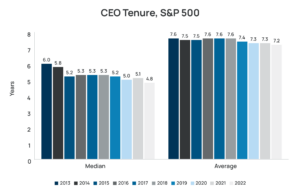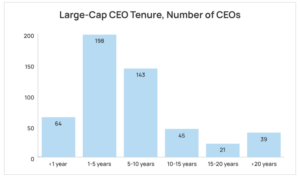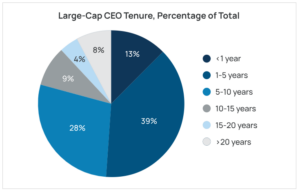Joyce Chen is an Associate Editor at Equilar. This post is based on a Equilar memorandum by Ms. Chen and Carol Jerotich.
Chief executive officer (CEO) tenure rates have experienced a significant decline in the past decade. A recent study conducted by Equilar—featured in Barron’s annual Top CEOs issue—has brought the change to light, uncovering a substantial shift in both the median and average tenures of S&P 500 CEOs.
Specifically, the median tenure among the S&P 500 companies has decreased 20% from six years in 2013 to 4.8 years in 2022. Although the average tenure also decreased during this period, the decline was comparatively modest. In 2013, average CEO tenure stood at 7.6 years, and by 2022, it had dropped slightly to 7.2 years. While this represents a 5.3% drop, the contrast between the median and average tenure is worth noting.
The disparity between median and average tenure figures signifies there is a subset of chief executives who have held their positions for relatively longer periods, skewing the average upward. In the aforementioned Barron’s article, Andy Serwer coined the term “forever CEOs” to describe CEOs with lengthy tenures. One example is Jensen Huang, the CEO of Nvidia, who has maintained his position for over 30 years. On the other hand, the median, which represents the midpoint of the data set, provides a more accurate reflection on the overall trend. Between 2013 and 2022, the 20% decrease in median tenure compared to the approximate 5% decrease in average tenure indicates a considerable amount of chief executives are experiencing notably shorter terms in their leadership roles.
The data reveals 39% of S&P 500 CEOs have tenures ranging from one to five years, and 28% maintain tenures falling between five to 10 years. Interestingly, these two percentages alone account for over 50% of the CEOs involved in this study, indicating a majority of them serve for 10 years or less. Yet, a smaller percentage of the executives, 8%, have tenures exceeding 20 years, signifying the rarity of such long-term executive positions.
Several factors have contributed to the trend of shortened CEO tenures in recent years. The role and responsibilities of chief executives have evolved significantly over the past decade, demanding higher levels of accountability and adaptability. CEOs now face a rapidly changing business landscape with increased competition, technological advancements and shifting consumer demands.
The COVID-19 pandemic has undoubtedly played an underlying role in accelerating the decline of CEO tenure. These chief executives were required to navigate their organizations in the midst of major shifts including economic turmoil, supply chain disruptions and uncertainties in the market. This led to CEOs having to make critical decisions quickly and adapt their strategies to ensure the survival and stability of their companies. While there was a slight increase in CEO tenure in 2021, likely due to the hopeful outlook on the economy’s recovery from the pandemic, the numbers declined again in 2022 as new challenges arose, such as supply chain issues and inflation.
The declining tenure rates continue to reflect the challenges CEOs currently face, and the ability for them to navigate these changes and drive sustainable growth remains vital in shaping today’s competitive business environment.
 Print
Print

